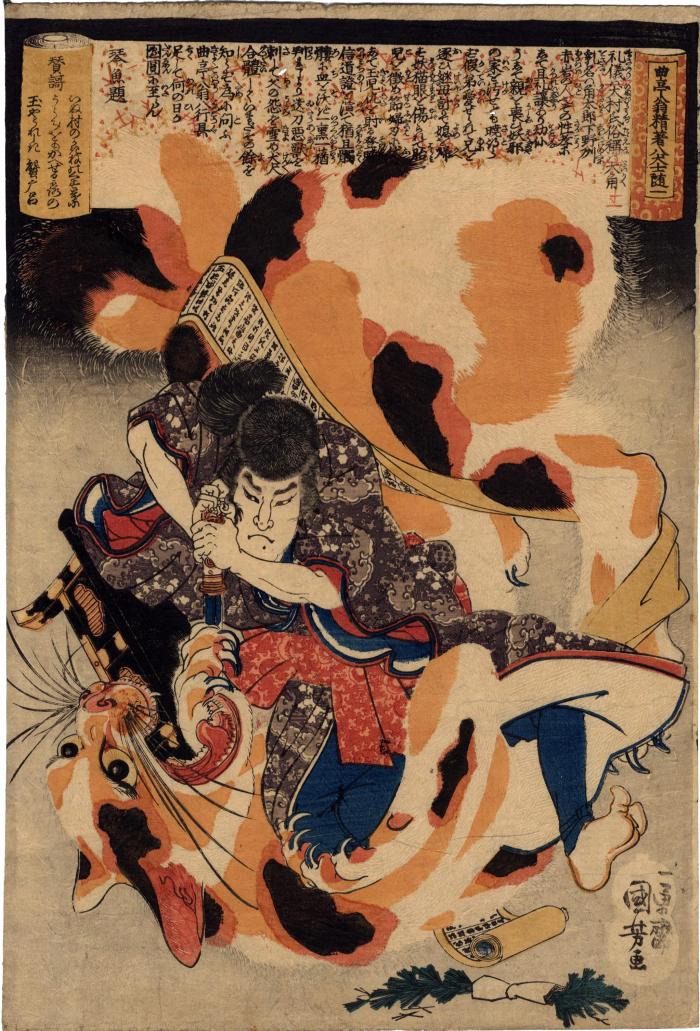Utagawa Kuniyoshi (歌川国芳) (artist 11/15/1797 – 03/05/1861)
Inumura Daikaku stabbing the gigantic cat from the series Kyokutei-ō seicho Hakkenshi zui-ichi The Eight Dog Heroes of the Master Author Old Kyokutei Bakin - 曲亭翁精著八犬士随一
ca 1835 – 1836
10 in x 15 in (Overall dimensions) Japanese woodblock print
Signed: Ichiyūsai Kuniyoshi ga
一勇斎国芳画
British Museum - ascribed to Nishimuraya Yohachi without a seal
Tateyama City Museum
Hagi Uragami Museum of Art - with Nishimuraya Yohachi and kiwame seals
Funabashi City Library
Nationaal Museum van Wereldculturen (Rijksmuseum Volkenkunde, Leiden) via Ritsumeikan University
Hiroshige Museum of Art, Ena As described by the British Museum: "Inumura Daikaku driving his sword into a giant enchanted cat, which is wrapped in a long scroll."
****
"The most feared variety of demon-cat has a forked or double tail and is called nekomata, forked cat. In the 'Hakkenden', a novel by Bakin (1767-1848) a cat with double tail is killed by one of the heroes, one of the 'dogs'... Inamura Daikaku. The demon cat of Nabeshima has become a classic."
Quoted from: The Animal in Far Eastern Art: And Especially in the Art of the Japanese Netzsuke, with References to Chinese Origins, Traditions, Legends, and Art by T. Volker, p. 27.
****
"Japan acquired not only the domestic cat (neko) from China but also superstitious about the animal, including the belief that it disguised itself in human, usually female, form. This tradition is reflected in Edo-period woodblock prints of a fierce and huge witch-cat being slain by Inumura Daikaku, a hero of the Hakkenden."
Quoted from: Symbols of Japan: Thematic Motifs in Art and Design by Merrily Baird, p. 126.
****
There is another, much more sedate, print featuring Inumura Daikaku in the Lyon Collection. It is by Shigeharu.
There is another copy of this print in the collection of the National Galleries of Scotland. However, it no longer can be found online.
****
The text reads partially: 礼儀は犬村氏 俗称は大角 乳名は角太郎 下野州赤いわの人也 その性孝にして且礼譲あり 幼少うして親を喪ひ妖邪の家を汚せども暁得らず 仮弟愛せられて兄を逐ひ継母計りて息を帰す 妖猫眼を傷られて胎
****
Illustrated:
1) in a small black and white reproduction in Kuniyoshi: The Warrior Prints by B. W. Robinson, Cornell University Press, Ithaca, 1982, p. 107. S5.8.
2) in a black and white (xerox?) copy in 'Artistic and Religious Aspects of Nosatsu (Senjafuda)' by Mayumi Takanashi Steinmetz - a Master's Thesis, University of Oregon, June 1985, fig. 38, p. 148.
3) in color in Japanese Yōkai and Other Supernatural Beings: Authentic Paintings and Prints of 100 Ghosts, Demons, Monsters and Magicians by Andreas Marks, Tuttle Publishing, 2023, p. 27. This exact print is the one illustrated in this volume.
Nishimuraya Yohachi (西村屋与八) (publisher)
Hakkenden (The Eight Dog Heroes - 八犬伝) (genre)
Yūrei-zu (幽霊図 - ghosts demons monsters and spirits) (genre)
Kyokutei Bakin (曲亭馬琴) (author)
